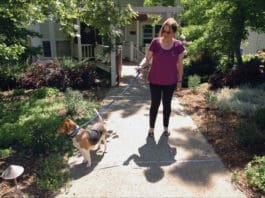When One Is Not Enough
For many of us who love dogs, our canine family members are a lot like potato chips - we can't have just one. There...
How You Can Help With the Animal Shelter Crisis
A perfect storm has hit the animal rescue world, and many shelters nationwide are bursting at the seams. Fostering is one way to help during the current animal shelter crisis. By taking a dog out of a shelter and fostering, you may even save another dog's life by freeing up kennel space in a facility.
Gold Paw Dog Training Program
The Gold Paw Program was developed by the Humane Society of Washington County, Maryland, (HSWC) to help identify and work with dogs who have the potential to be someone’s beloved companion, but need some help getting there. Gold Paw volunteers undergo extensive training in canine behavior so they are prepared to provide these dogs with the help they need.
What Is a Purebred Dog?
A purebred dogs is simply a dog bred from parents of the same phenotype while a mixed breed dog is bred from two or more phenotypes.
What’s The Best Source for Purebred Dogs?
The fact is, purebred dogs are everywhere. You can find them at shelters, in rescue groups, free in the newspaper, running loose in the streets, for sale by breeders, and, unfortunately, in pet stores. There are pros and cons to acquiring your next family member from any of these sources; you can find good dogs from any one of them, but each venue can also supply you with dogs with minor to severe health and behavior problems. Much of the dog breeding industry seems to subscribe to the caveat emptor" philosophy. The average dog owner is very much on her own when it comes to acquiring a new canine companion
Adding a New Dog to a Multi-Dog Household – Plan Ahead!
Are you thinking about adding a second (or third, or fourth) dog to your household? Will your current dog be thrilled with a new friend? Will the dogs play with each other, romp together, and keep each other company in your absence? Or will adding another dog to your home create disharmony, chaos, or worse?
Why Adopting an Adult Dog Has its Advantages
So, you've recently adopted an adolescent or adult dog, or you're planning to adopt one from a rescue group or shelter in the near future. Good for you! It generally takes adult dogs a lot longer to get adopted than those irresistible, pudgy puppies even when they are calmer, better-socialized, house-trained, and past the chew everything in sight" stage. Shelter staffers often shake their heads as families pass up ideal
The Best Family Dogs
If you are looking for a dog who will make a fantastic addition to your family, what you should be looking for is an individual dog with specific canine personality traits that are conducive to family life.
Too Mean To Keep?
I have a serious problem with my six-year-old neutered male Vizsla. He was a high strung, but good tempered dog for the first three years of his life. Something seemed to snap after that. He is loving and affectionate most of the time, but he gets aggressive when family members leave the kitchen (he and our other dog are limited to the kitchen and family room). He barks, snaps at them, and snags clothes with his teeth. He has never chomped down and bitten anyone, but he has scratched people with a tooth.
A New Dog’s Blues
A long-time dog lover, Marci Boothe volunteers at the Santa Cruz (California) SPCA walking adoption dogs. She had assumed that her landlady wouldn’t approve of her keeping a dog in her small rental unit, so she got her “dog fix” by giving love and attention to shelter dogs. But then came Stella, a year-and-a-half-old Border Collie mix. The winsome young dog arrived at the SPCA in July of 1998.
Dog Rehoming: When Is It the Right Decision?
the harder she will be to rehome. Dogs who are very old
How to Help a Shelter Dog Find a Home
Many animal lovers in this country are aware of an epidemic that’s affecting our companion dogs and cats. There’s no easy cure; at best we can apply palliative measures. The epidemic? Rampant homelessness. According to the Humane Society of the United States, 6 to 8 million dogs and cats enter shelters each year – and fully half of them are euthanized because they run out of time or are not considered adoptable.

















